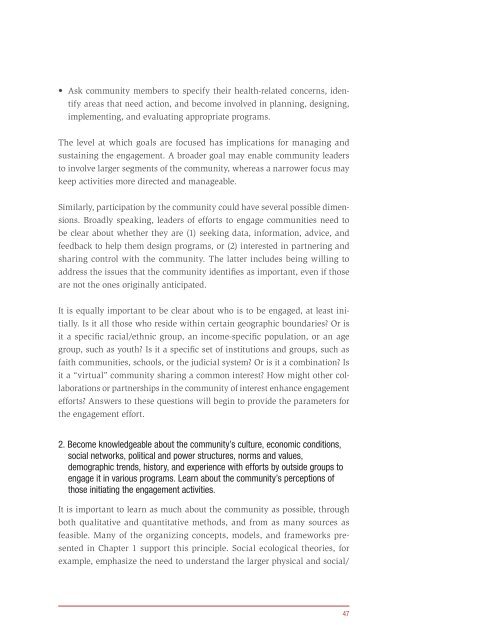Principles of Community Engagement (Second Edition)
Principles of Community Engagement (Second Edition)
Principles of Community Engagement (Second Edition)
You also want an ePaper? Increase the reach of your titles
YUMPU automatically turns print PDFs into web optimized ePapers that Google loves.
• Ask community members to specify their health-related concerns, iden-<br />
tify areas that need action, and become involved in planning, designing,<br />
implementing, and evaluating appropriate programs<br />
The level at which goals are focused has implications for managing and<br />
sustaining the engagement A broader goal may enable community leaders<br />
to involve larger segments <strong>of</strong> the community, whereas a narrower focus may<br />
keep activities more directed and manageable<br />
Similarly, participation by the community could have several possible dimensions<br />
Broadly speaking, leaders <strong>of</strong> efforts to engage communities need to<br />
be clear about whether they are (1) seeking data, information, advice, and<br />
feedback to help them design programs, or (2) interested in partnering and<br />
sharing control with the community The latter includes being willing to<br />
address the issues that the community identifies as important, even if those<br />
are not the ones originally anticipated<br />
It is equally important to be clear about who is to be engaged, at least initially<br />
Is it all those who reside within certain geographic boundaries? Or is<br />
it a specific racial/ethnic group, an income-specific population, or an age<br />
group, such as youth? Is it a specific set <strong>of</strong> institutions and groups, such as<br />
faith communities, schools, or the judicial system? Or is it a combination? Is<br />
it a “virtual” community sharing a common interest? How might other collaborations<br />
or partnerships in the community <strong>of</strong> interest enhance engagement<br />
efforts? Answers to these questions will begin to provide the parameters for<br />
the engagement effort<br />
2. Become knowledgeable about the community’s culture, economic conditions,<br />
social networks, political and power structures, norms and values,<br />
demographic trends, history, and experience with efforts by outside groups to<br />
engage it in various programs. Learn about the community’s perceptions <strong>of</strong><br />
those initiating the engagement activities.<br />
It is important to learn as much about the community as possible, through<br />
both qualitative and quantitative methods, and from as many sources as<br />
feasible Many <strong>of</strong> the organizing concepts, models, and frameworks presented<br />
in Chapter 1 support this principle Social ecological theories, for<br />
example, emphasize the need to understand the larger physical and social/<br />
47

















